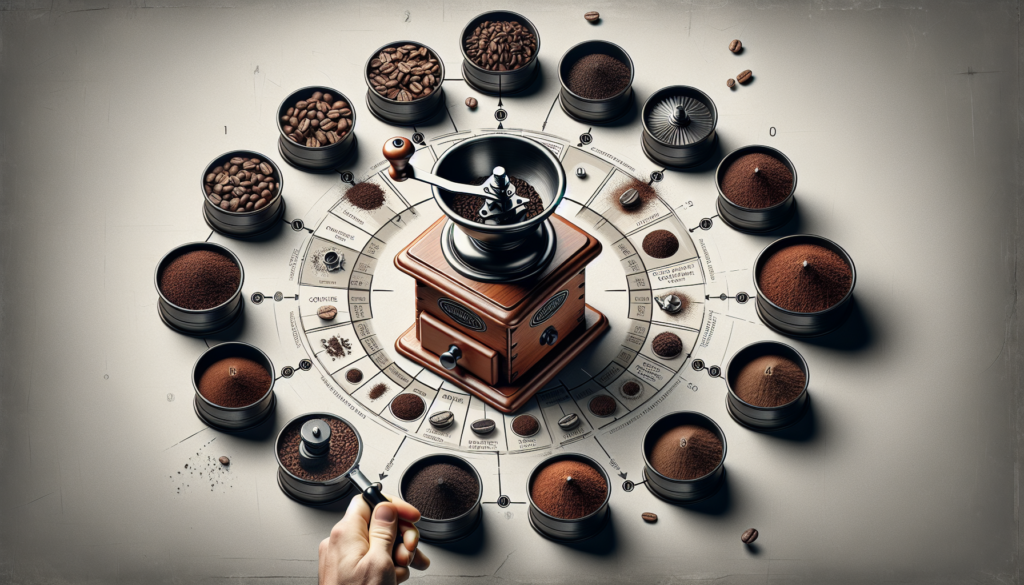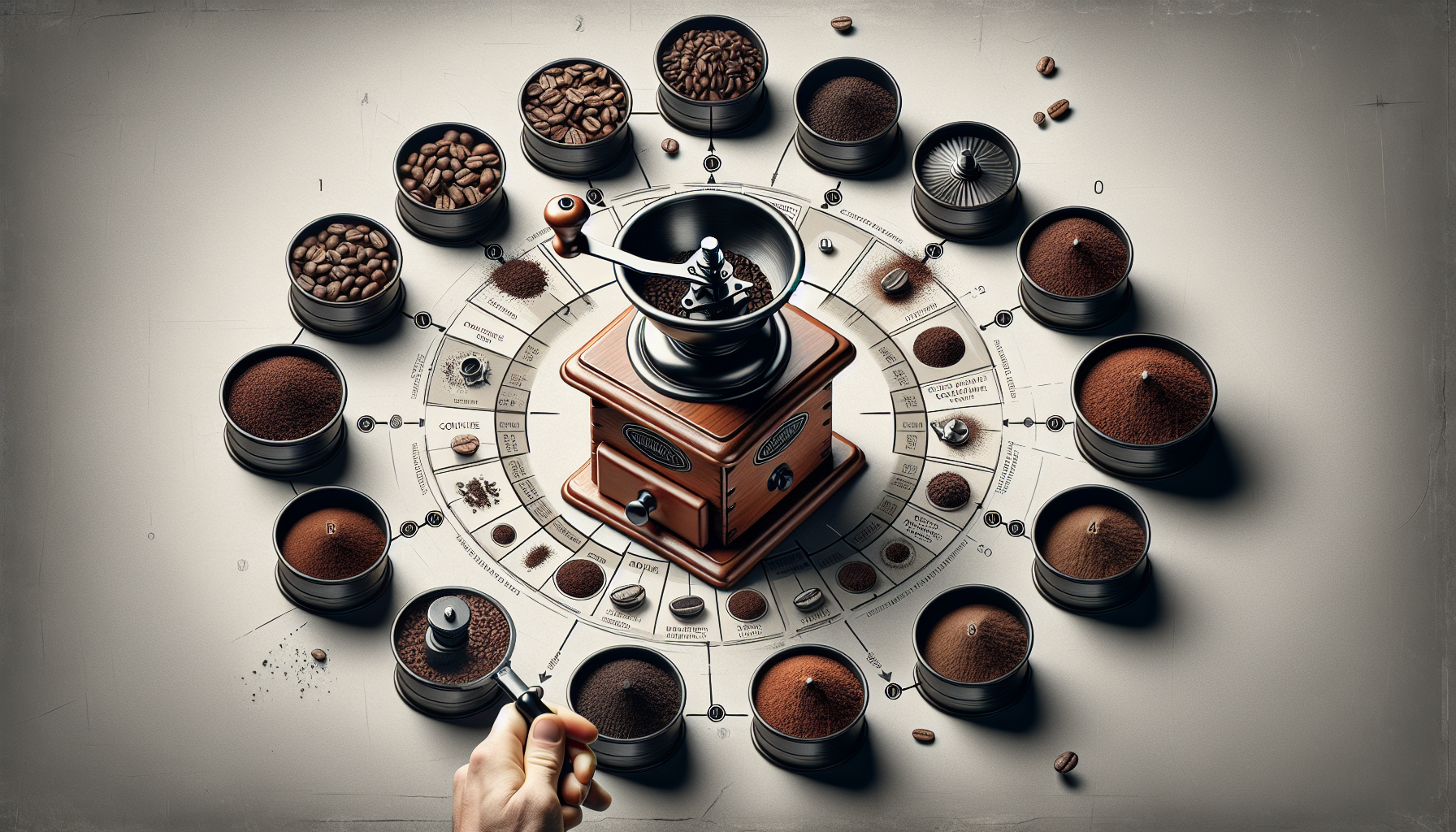Have you ever wondered how grinding coffee affects the taste of your morning cup? Well, the answer may surprise you! Grinding coffee plays a crucial role in determining the flavor and aroma of your brew. From the type of grinder to the level of grind, each choice you make can have a noticeable impact on the taste. So, let’s take a closer look at how grinding coffee affects taste and discover some tips to elevate your coffee experience.

CHECK OUT COFFEE GRINDERS ON AMAZON
Effects of Grinding Coffee Beans
Grinding coffee beans is a critical step in the coffee brewing process that can greatly influence the taste and quality of your cup of joe. By breaking down the beans into smaller particles, grinding exposes a larger surface area of the coffee, allowing for a more efficient extraction of flavor compounds. Let’s delve into the various effects that grinding coffee beans has on the final taste and aroma of your favorite morning beverage.
Particle Size Distribution
One of the primary effects of grinding coffee beans is the creation of different particle sizes, known as the particle size distribution. Consistency in particle size is crucial to achieving the desired flavor profile in your coffee. When the particles are uniformly sized, you enhance the extraction process and ensure a more balanced and flavorful cup.
Importance of Consistency
Consistency in your grind size is paramount to brewing a delicious cup of coffee. A consistent grind size enables an even extraction of flavor, preventing any over-extraction or under-extraction. This consistency allows for a more controlled brewing process and ensures equal extraction rates across all the grounds, resulting in a harmonious taste profile.
Different Grind Sizes
Different brewing methods call for various grind sizes to optimize extraction. Coarser grind sizes, such as those used in French press or cold brew, result in a slower extraction process, yielding a richer and more full-bodied cup. Finer grind sizes, on the other hand, are suitable for espresso machines and Turkish coffee, as they provide a faster extraction and intensify the flavors.
Brewing Methods
Each brewing method requires a different grind size to extract the desired flavors effectively. For instance, a medium-fine grind is ideal for pour-over methods like V60 or Chemex, as it allows for a balanced extraction without any bitterness. Understanding the specific grind size recommendation for your preferred brewing method is essential to unlocking the true potential of your coffee beans.
Extraction Efficiency
The size of coffee particles directly influences the extraction efficiency. Smaller particles have a greater surface area and, as a result, extract more flavor compounds during brewing. On the other hand, larger particles may release some flavors less effectively. Achieving the right extraction rate depends on finding the appropriate grind size for your brewing method, ensuring that you extract the desired flavors without any undesirable bitterness.
Extraction Rate
The extraction rate refers to the speed at which flavors are extracted from the coffee grounds during brewing. It is influenced by several factors, such as contact time, water temperature, and grind size. Finding the perfect balance between these variables is essential to achieve the ideal extraction rate for a well-balanced cup of coffee.
Contact Time
Contact time plays a significant role in the extraction rate, as it determines how long the water stays in contact with the coffee grounds. For example, a longer contact time, as seen in French press brewing, requires a coarser grind size to avoid over-extraction. Conversely, espresso brewing requires a finer grind and a shorter contact time to ensure optimal extraction.
Extraction Yield
The extraction yield refers to the percentage of soluble compounds that have been extracted from the coffee grounds during brewing. Achieving an ideal extraction yield is crucial for balancing flavors and avoiding over-extraction or under-extraction. Grind size directly impacts the extraction yield, with finer grounds yielding a higher extraction rate.
Under-Extraction
Under-extraction occurs when the coffee grounds are not adequately extracted, resulting in a weak and sour-tasting cup. This can happen when the grind size is too coarse or when the brewing time is too short, preventing proper extraction of the desirable flavor compounds.
Over-Extraction
Conversely, over-extraction happens when the coffee grounds are overly extracted, leading to a bitter and unpleasant taste. Over-extraction can occur due to a grind size that is too fine or a brewing time that is too long, causing the extraction process to draw out undesirable compounds.
Ideal Extraction
Achieving the ideal extraction requires finding the perfect balance between under-extraction and over-extraction. This balance leads to a well-rounded, flavorful cup of coffee that highlights the nuances and complexities of the beans. Experimenting with different grind sizes and brewing times allows you to find the sweet spot that suits your taste preferences.
Surface Area
Grinding coffee beans increases the overall surface area of the grounds, contributing to a more efficient extraction of flavor compounds. The larger the surface area, the faster and more evenly the flavors can be extracted, resulting in a richer and more vibrant cup of coffee.
Increased Surface Area
Breaking down coffee beans into smaller particles creates a greater surface area for water to interact with during brewing. This increased surface area allows for more efficient extraction, ensuring that the flavors are released and dissolved at a faster rate.
Time for Extraction
With a larger surface area, the extraction process is accelerated. This means that the flavors are extracted more quickly, reducing the brewing time required to achieve the desired taste profile. However, it is crucial to find the right balance, as an excessively fast extraction can lead to over-extraction and a bitter taste.
Sensory Perception
The increased surface area obtained through grinding coffee beans also affects the sensory perception of the final cup. The finer particles intensify the aroma, allowing for a more aromatic experience when brewing. Additionally, the increased surface area enhances the overall flavor profile, resulting in a more nuanced and enjoyable taste.
Oxidation
Oxidation is another factor influenced by grinding coffee beans. When coffee beans are exposed to air, they undergo oxidation, leading to flavor degradation and a loss of freshness. Proper grinding techniques and equipment can minimize exposure to air, preserving the flavors and prolonging the shelf life of the coffee.
Exposure to Air
During the grinding process, coffee beans are exposed to air, initiating the oxidation process. The longer the beans are exposed, the more pronounced the flavor degradation becomes. It is crucial to grind your coffee immediately before brewing to minimize the effects of oxidation and preserve the freshness of the beans.
Flavor Degradation
Oxidation can result in a degradation of the flavors present in the coffee beans. This degradation may lead to a loss of the coffee’s original taste profile, resulting in a dull or stale cup. By grinding your coffee just before brewing, you can maximize the retention of the flavors and enjoy a more vibrant and flavorful cup.
Staling
Staling refers to the process by which the brewed coffee loses its freshness and becomes flat in flavor. Grinding your coffee beans in advance can contribute to this staling process due to increased exposure to air. To maintain the freshest taste, it is best to grind your beans immediately before brewing to minimize staling.
Use of Burr Grinders
Using a burr grinder can significantly reduce the exposure of coffee beans to air during the grinding process. Burr grinders crush the beans between two abrasive surfaces, resulting in a consistent grind size while minimizing oxidation. By investing in a burr grinder, you can enhance the flavor and freshness of your daily cup.
Carbon Dioxide Release
The process of grinding coffee beans also releases carbon dioxide gas. This release has implications for the flavor and brewing process, particularly in espresso brewing, where the presence of carbon dioxide plays a crucial role.
Gas Release during Grinding
When coffee beans are ground, carbon dioxide gas is released due to the breakdown of cell walls within the beans. This gas release can contribute to the formation of a crema in espresso brewing and impact the extraction process, intensifying the flavors and adding a distinct characteristic to the cup.
Fresher Taste
In espresso brewing, the presence of carbon dioxide can result in a fresher taste. The release of carbon dioxide enhances the aromatic experience and contributes to a more vibrant and flavorful cup. However, it is important to note that excessive carbon dioxide release can also negatively impact the brewing and extraction process.
Espresso Extraction
Espresso brewing relies on the interaction of pressurized water with finely ground coffee to extract the flavors and create a concentrated shot. The presence of carbon dioxide, as well as the optimal grind size, is essential in achieving the desired extraction rate and flavor profile when brewing espresso.
Grinding Methods
There are several methods of grinding coffee, each with its own advantages and disadvantages. Understanding the differences can help you choose the right grinding method for your specific needs and preferences.
Blade Grinders
Blade grinders are commonly found in many households due to their affordability and availability. These grinders use sharp blades to chop the coffee beans, resulting in an uneven grind size. While they are convenient, blade grinders can lead to inconsistent extraction and may produce a more bitter taste.
Burr Grinders
Burr grinders, on the other hand, offer a more precise and consistent grind size. They crush the beans between two burrs, resulting in a uniform particle size distribution. Burr grinders allow for more control over the extraction process and produce a higher quality cup of coffee.
Manual Grinders
Manual grinders provide a hands-on and traditional approach to grinding coffee. These grinders require manual effort to operate, often utilizing a crank or handle to crush the beans. While they may take longer to grind the coffee, manual grinders offer more control and can produce a consistent grind size.
Electric Grinders
Electric grinders offer convenience and speed in the grinding process. With the push of a button, these grinders quickly and efficiently grind the coffee beans to your desired consistency. They are ideal for those seeking a hassle-free grinding experience and are often favored by coffee professionals.
Grind Size Recommendations
Different brewing methods require specific grind sizes to achieve optimal extraction. Here are some general recommendations for grind sizes based on the brewing method:
- Coarse Grind: Ideal for French press and cold brew methods, where a longer contact time is required to extract the flavors effectively.
- Medium-Coarse Grind: Suitable for devices like Chemex and Hario V60, producing a balanced and clean cup of coffee.
- Medium Grind: Commonly used for drip coffee makers, this grind size offers a well-rounded extraction and balances acidity and body.
- Medium-Fine Grind: Perfect for pour-over methods like Kalita Wave or Aeropress, where a shorter contact time is preferred.
- Fine Grind: Primarily used for espresso machines, this grind size provides a rapid extraction and a concentrated, full-bodied flavor.
- Extra-Fine Grind: Generally used for Turkish coffee, where the coffee is brewed unfiltered, resulting in a strong and intense cup.
Factors Affecting Grinding Consistency
Several factors can affect the consistency of your grind and, subsequently, the overall brewing process. Understanding these factors allows you to make adjustments and ensure a consistent grind size for a better cup of coffee.
Bean Age
The age of the coffee beans can impact the grind consistency. Fresher beans tend to be more brittle and grind more consistently, while older beans may be tougher and result in an uneven grind. Using fresh beans can contribute to a more consistent and enjoyable brewing experience.
Bean Quality
The quality of the coffee beans also influences the grind consistency. Higher-quality beans tend to have a more uniform density, resulting in a more consistent grind size. It is always recommended to opt for freshly roasted, specialty-grade beans to maximize the flavor and consistency of your coffee.
Burr Sharpness and Alignment
The condition and sharpness of the burrs in the grinder can significantly impact the grind consistency. Dull or misaligned burrs may produce inconsistent particle sizes, leading to uneven extraction. Regular maintenance and sharpening of the burrs are necessary to maintain a high level of consistency in your grind.
Grinder Stability
The stability of the grinder during the grinding process can affect the consistency. A stable and well-built grinder prevents unnecessary movements that could lead to variations in grind size. Investing in a high-quality grinder with a stable construction can contribute to a more uniform grind.
Grind Time and Speed
The duration and speed at which you grind your coffee can also affect the consistency. Grinding too quickly or for too long can result in an uneven grind. Finding the right balance and adhering to the recommended grind time can help achieve a more consistent grind size.
Conclusion
Grinding coffee beans is a crucial step in the coffee brewing process, influencing the taste, aroma, and overall enjoyment of your cup. From the particle size distribution to the extraction rate, surface area, oxidation, and carbon dioxide release, every aspect of grinding impacts the final result. By understanding these effects and utilizing proper grinding techniques, you can elevate your coffee brewing experience and savor the flavors of your favorite beans in every sip. So, grab your grinder, experiment with different grind sizes, and embark on a flavorful journey to unlock the true potential of your coffee.

